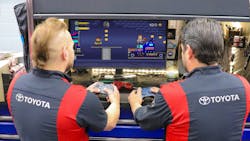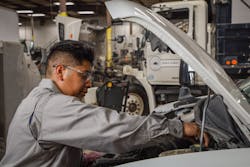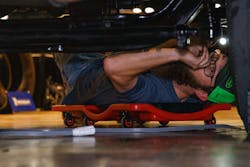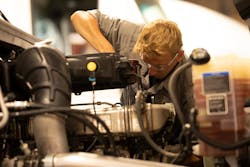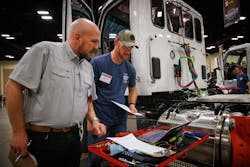With most maintenance shops offering comparable pay, shop owners and managers must distinguish themselves in other ways to attract and retain labor while motivating them to be as safe, productive, and efficient as possible.
Money alone can't buy consistent productivity or loyalty—all you get are maintenance mercenaries who will leave when the job gets too complex or tedious. There's also the threat that another shop gives them a better offer. You can differentiate your operation, though, by making it a place where technicians, service writers, and parts personnel look forward to working 40-plus hours a week, 50-plus weeks a year.
See also: Report: Independent repair shops desperate for techs, parts
"Work doesn't have to suck—you should have fun," offered Chris O'Brien, COO at Fullbay, which provides shop management software and regularly hosts virtual discussions on how shop owners can better connect with their workers.
"Going to work day in and day out where it actually feels fun and engaging can make a huge difference," added Jacob Findlay, Fullbay's founder and executive chairman.
There is a science to fun, though. Fullbay's platform collects and measures data to help maintenance operations increase productivity and revenue. Findlay advises that fleets and shops ought to combine their data with some friendly competition and rewards. This will, in turn, help the whole shop reach a winning strategy for uptime and efficiency.
In short, turn work into a game.
Strategies to get workers more engaged
We all knew this intuitively as children, but the stresses and responsibilities that come with age have a way of shoving such notions into the recesses of our minds. The grown-up word for it is gamification. This is basically leveraging techs' competitive nature, along with incentives such as cash bonuses, trophies, trips, and intrinsic rewards, to help achieve a company goal, whether that's completing a project on time, boosting revenue, or improving quality. Let's call it what it is: a way to make work suck less.
This strategy, which has been formally around for more than a decade, is growing in popularity among fleets.
"Gamification is being used more and more among commercial fleets," said Belinda Rueffer, Fleetio VP of marketing, based on customer conversations.
"What started as a fun way to get drivers engaged in building a culture of safety—by creating safe driver leaderboards and tying financial and recognition-based rewards to drivers who exhibit safe driving habits—has now extended beyond safety to driver engagement in general, and even into in-house and outsourced maintenance shops."
Rueffer believes gamification is more than "a passing trend" and sees it "as a gradual shift that helps fleets recruit, engage, and retain top talent."
One of Fullbay's customers, Iron Buffalo Truck and Trailer Repair (formerly JE-CO Truck & Trailer) has found that gamifying the shop does that and more. The shop's business model is to provide premium service that costs less than a dealership, so happy, focused, and productive technicians are essential.
"We try to come up with creative ways to inspire them," said co-owner Mike Schwarz at the 2023 TMCSuperTech competition in Cleveland. He and the shop's other owner, Austin White, were there to support their director of training and technician development, Ian Matje, who won the Automated Manual Transmission, EV, and cybersecurity stations in the heavy-duty track.
See also: Cox Automotive highlights its top technicians' skills
The top biller of the year gets a trip for themselves and their significant other. The first winner chose Hawaii. That choice somehow took Schwarz and White by surprise. They hadn't planned on such an extravagant locale but did find a way in the budget to honor the request, and the other techs were more motivated than ever to win. Iron Buffalo also brings on apprentices from local schools, and in the program's three years, all have chosen to stay on at the shop.
"And they're billing consistently—50 to 70 hours a week—as 19- or 20-year-olds," offered White, who added they "are extremely loyal." Matje, a former diesel school instructor, was hired six months ago to run the apprenticeship and overall training.
"They are worth every penny that we've invested in the program and extremely loyal," White continued.
The gamification is enabled by the standardized training Matje provides. Together, they serve as a major shop powerup.
"What we see is that there is a return in terms of the productivity of the staff and the quality of their work and a reduction in comebacks, and in turn, the amount of revenue that we can generate with the same space," Schwarz said.
Getting started isn't all fun and games, though. There's a science to gamifying a shop, and the strategy can take many forms and fail in many ways. Here's a guide that should help get you started.
Ground rules are about company goals
Before you decide on fun stuff, like how the game will be played and the rewards, you have to establish some basic rules, such as what company goal you want to achieve or metrics you want to improve.
"As far as driving operational betterness or improvement, you've got to have alignment between whatever you're measuring with this gamification and what you want to achieve as an organization," Findlay explained. "It can't just be going around and shooting each other with Nerf guns and calling it 'gamification.'"
An easy target is technician efficiency. For this, take a technician's total hours worked and divide by hours billed.
"If they bill 30 hours in a week, and they're on the clock for 40 hours, that would be 75% efficiency," he said.
See also: WyoTech rises to meet increasing technician demand
Gamifying utilization can also unearth some hidden inefficiencies.
"You might have a hotshot tech who can get 40 hours worth of work done in 20 hours and then sits around for another 20 hours," Findlay said. "What if we could get them to work the other 20 hours?"
A tech being utilized only half of the time should signal to leadership they need to find a way to keep them more engaged. This could also help a shop identify efficient techs who need help billing more hours.
Then, talk to the would-be players, the technicians, or other employees involved about what type of game would keep them engaged. Without willing participants, a game is not much fun after all.
Make sure the game is winnable (so don't set unachievable goals), O'Brien explained. Playing the game must also drive positive employee behavior. He added that it is essential to encourage overachieving on the goal, so don't cap incentives once players reach 100%. Even a gamer who considers themselves a 'completionist' will likely stop at that point. Video games may have an end screen, but profitability does not.
Do no harm: Safety over speedy
Unlike video games, there are no extra lives in the real world, so like with anything in the transportation industry, safety should not be sacrificed, no matter what. If your goal is to increase mean time to repair, and your shop mostly does brakes and wheel-end service, incentivizing your techs to speed through service is a dangerous proposition.
Even if it doesn't result in "game over" for someone on the road, sloppy work will kill repeat business.
"There is a difference between a speedy, quality repair that should be rewarded compared to a fast (shortcut) repair that increases revenue for the shop but may lead to a return or unhappy customer because something was overlooked due to trying to increase sales numbers," warned Duane "Doc" Watson, a technical trainer at Bosch.
This doesn't mean it can't be done; it just can't be done carelessly.
"Auto repair shops can use gamification techniques to improve their mean time to repair/replace while maintaining safety by simply prioritizing safety alongside speed," Watson noted. "However, applying game-like elements to automotive repair, including brake jobs, such as rewards or challenges, takes a thoughtful approach. Shop owners must consider how they implement it before proceeding."
Watson advised that shops implement mandatory quality "checkpoints" to ensure the repairs go smoothly.
Iron Buffalo does track the comebacks, and the supervisors and the general manager have their own game going on: Who wants to lose their bonus?
"If the comebacks are too high, it lowers their bonus anywhere from 10 to 40%," explained Schwarz, a certified Agile coach. Cleanliness is scored on a 40-point inspection twice a week for each shift. Both serve as a "checks-and-balances" system to ensure quality.
Breeding resentment can be another pitfall. There is a fine line between friendly competition and "toxic competitiveness," Findlay noted. No incentive or prize can come at the cost of overall shop productivity or morale.
"You don't want the employees competing against each other; you want them competing against a benchmark so that everybody can hit it," he said.
"Because the whole goal is to get revenue and profit as high as possible, obviously, while you're taking care of the fleets," Findlay continued.
O'Brien also recommended that the game should have collective goals as well as individual rewards to encourage one outperforming tech to help the slower techs get better.
"We all can independently win, but we can't win big unless the team wins," O'Brien said.
At Iron Buffalo, the owners learned another excellent rule: include all departments, not just the techs. Seeing the techs get bonuses and trips to Hawaii resulted in some division among other departments, Schwarz recalled.
"We had to figure out how to incent the rest of these guys to really care about this stuff and feel like we're rewarding them like we're rewarding the technicians," he acknowledged.
The owners implemented a prize structure and visits to a Top Golf driving range. Service writer rewards are based on the average price per ticket and cycle times.
How to keep score within your truck maintenance operations
Once the game is underway, data should be provided in real-time and on a leaderboard.
Rush Enterprises, which operates 150 Rush Truck Care Centers, has a performance dashboard visible at every shop. It was an internally created system that displays relevant metrics from multiple sources, such as its SAP enterprise resource planning software.
"We have dwell analytics and all kinds of information on tech performance," said Victor Cummings, Rush's VP of service operations. "We measure productivity, efficiency proficiency, and what their effective rate is versus the door rate."
According to Cummings, the monitor displays the job each technician is working on and their hours on the job. Each entry is color-coded based on progress compared to standard repair time (SRT). The job starts green, then morphs to yellow when approaching, going over the expected time. It turns red when the tech is running behind.
Rush hosts an annual technician skills competition called Rush Rodeo and is "a pretty competitive company," Cummings said, but fixing trucks is always a team sport.
Javier Gonzales, director of service at Rush, explained that the foreman's dashboard, which was not initially accepted by techs, ended up making the whole unit stronger. "It actually allowed our technicians to help each other out," he recalled. "They'd see another technician struggling—going over SRT time—and ask, 'Hey, is there anything I can help with?'"
In addition, it helps management with performance reviews and helps locations discover what they do well and what needs to be improved. This type of transparency is vital to the success of a gamification project and a shop in general.
"We've seen by exposing metrics and stuff that efficiency tends to go up," said Findlay.
Findlay likened it to keeping score in a pickup game of basketball, where not keeping score leads to people just nonchalantly lobbing the ball up and not caring if it goes in.
"As soon as you start keeping score, suddenly everybody becomes engaged—and there's no money involved in that," he said.
According to a 2017 Gallup study, business units that reported high employee engagement rates were 21% more profitable. Highly engaged businesses also enjoyed a 17% increase in productivity and a 24% turnover reduction.
Rewards: It's not all about the money
An important thing to keep in mind when deciding which employees should win is that it's not all about the money.
Findlay referenced the Hawthorne effect, a sociological belief that a worker's productivity increases when being observed due to intrinsic or intangible benefits. Once a worker has enough money to meet their needs, motivation should include—but also must extend beyond—cold, hard cash, he argued.
An independent shop, for example, can track each technician's actual hours worked compared to hours billed and put it on a leaderboard for all to see. When they see that they may have billed 38 hours while a co-worker has billed 46, Findlay said that "gets the competitive juices flowing."
Jenny Baker-Ford, manager of fleet maintenance at Mike Albert Fleet Solutions, a leasing and maintenance provider, said this is even more true with younger generations.
"When you're talking about millennials, they think differently, and they need to be rewarded differently," she said. "It's not always about the money with them."
Findlay agreed.
"You don't motivate this generation by throwing chairs," he said. "Do it in other ways, like gamification."
Whether tied to a gamified reward or not, they might accept more time off as opposed to money or even recognition.
Rush's Gonzales noted even recognition from leadership at a shop goes a long way.
"They recognize those technicians who go above and beyond to better serve our customers and get their asset back on the road," the former tech said.
When team goals are met, the shop may even spring for morning tacos or even a food truck visit.
Fullbay's O'Brien recalled during his time at Shamrock Foods, rudimentary gamified tactics worked like a charm. They boosted morale for a Six Sigma project by moving a paper goat up a mountain at the weekly meeting when goals were met and shifted cardboard football players down a fabricated field when revenue targets were hit.
"It changed the dynamics of walking into work every day because people wanted to see where we were at playing the game," he noted.
As mentioned earlier, Iron Buffalo's Hulk trophies are a physical sign of a job well done, though even digital badges can work. On the Fullbay app, bosses can award badges for mastery of preventive maintenance or earning a new certification.
Findlay noted shops can create a point system for various accomplishments and provide physical patches, such as a long stretch without comebacks or for solving an unusually tough diagnostic issue. Fullbay gives these to its employees as intrinsic rewards when their actions reflect the company's core values.
The "running into the fire" patch has a flame on it and signifies the employee is "the kind of person who runs in and helps somebody and resolves the issue," O'Brien said. There's also a work-life balance badge to discourage employees from getting burned out.
None of this should be considered a replacement for giving workers the wages they deserve, Findlay reminded.
"Obviously, you're going to pay your employees—and you want to pay them well, but if you're missing that intrinsic component, you're missing out big time in terms of keeping your employees engaged, getting the absolute best efficiencies out of them, and probably retaining them as employees," he concluded.
About the Author
John Hitch
Editor
John Hitch is the editor-in-chief of Fleet Maintenance, providing maintenance management and technicians with the the latest information on the tools and strategies to keep their fleets' commercial vehicles moving. He is based out of Cleveland, Ohio, and was previously senior editor for FleetOwner. He previously wrote about manufacturing and advanced technology for IndustryWeek and New Equipment Digest.
